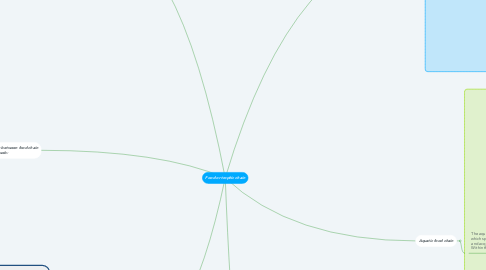
1. Terrestrial food chain
1.1. Within the terrestrial food chain, three different roles are identified:
1.1.1. Producers
1.1.1.1. They are the vegetables that produce energy from sunlight.
1.1.2. Consumers
1.1.2.1. Primary consumers
1.1.2.1.1. Species that feed on plants, fruits, or vegetables. For example: sheep, rabbit, giraffe, cow, etc.
1.1.2.2. Secondary consumers
1.1.2.2.1. The carnivorous species that feed on the primaries. For example: spider, snake, owl, etc
1.1.2.3. Tertiary consumers
1.1.2.3.1. Species that feed on primary and secondary consumers. Also called predators. For example: lion, tiger, golden eagle, etc.
1.1.3. Omnivores
1.1.3.1. Consumers of producers and primary consumers (plants and animals). For example: squirrel, fox, some turtles and the human being.
1.1.4. Decomposers
1.1.4.1. Species that feed on the remains of lifeless organisms, which later become part of the soil. For example: bacteria, insects, fungi, etc.
2. Difference between food chain and food web:
2.1. FOOD CHAIN
2.1.1. The food chain, or alimentary, refers to a natural system by which energy is transmitted from one organism to another. When we refer to these systems in an ecological way, we use the term food web. A food chain refers to four main parts: - The sun, which is the main source of energy for all organisms - Producers (plants). - The consumers. - The scavengers.
2.2. FOOD WEB
2.2.1. A food web or food web, on the other hand, refers to a bunch of food chains that make up an ecosystem. It is a mass of connected food chains that intertwine at various points. A food chain describes a pattern through which energy is transmitted from plants or producers to consumers. The multiple food chains in a community are called a food web or food web.
3. Energy flow in an ecosystem
3.1. The energy flow is the use of primary and secondary products by organisms that in turn used herbivorous primary consumers on which secondary or carnivorous consumers feed. Energy is basic for the functioning of any ecosystem, thanks to the different interactions that occur between different organisms, energy flows from species to species.
3.2. Trophic levels
3.2.1. Trophic levels are the type of classification according to the type of diet that each species has. They are:
3.2.2. Autotrophs or producers
3.2.2.1. They constitute the first trophic level. They take energy from the sun and transform it into organic molecules rich in carbohydrates, lipids and sugars. The main producers in the different ecosystems are:
3.2.2.1.1. Aquatic ecosystems: algae
3.2.2.1.2. Terrestrial ecosystems: plants
3.2.3. Heterotrophs or consumers
3.2.3.1. They are those that are classified into:
3.2.3.1.1. Primary Consumers
3.2.3.1.2. Secondary Consumers
3.2.3.1.3. Tertiary Consumers
3.2.3.1.4. Decomposers
4. Within this chain are the following links:
4.1. PRODUCTORS
4.1.1. Also known as autotrophs, they are those species (basically plants) that make their own food through solar energy and simple substances.
4.2. First-order consumers
4.2.1. They are those species whose diet is based on plants, that is, they are herbivores.
4.3. Second order consumers
4.3.1. Also called secondary, they are carnivorous species, that is, they feed on other animals.
4.4. Decomposers.
4.4.1. Those species that ensure that the remains of the other links become part of the soil. In this link are fungi, worms and certain microorganisms that feed on plant and animal waste.
5. Aquatic food chain
5.1. The aquatic food chain charts the way in which species that live in water feed on and acquire energy from other species. Within this chain there are five levels:
5.1.1. Photoautotrophs
5.1.1.1. The base of the aquatic food chain is made up of certain single-celled organisms known as phytoplankton. They are producers that carry out the photosynthesis process thanks to sunlight and produce organic compounds in addition to oxygen.
5.1.2. Herbivores
5.1.2.1. Those aquatic species that have a plant-based diet. These species can live on the surface of the water (like jellyfish or mollusks).
5.1.3. Carnivores
5.1.3.1. Carnivorous species can be of different sizes. Sardines, octopus or squid are some of the species that make up this link.
5.1.4. Decomposers
5.1.4.1. Carnivorous species can be of different sizes. Sardines, octopus or squid are some of the species that make up this link.
